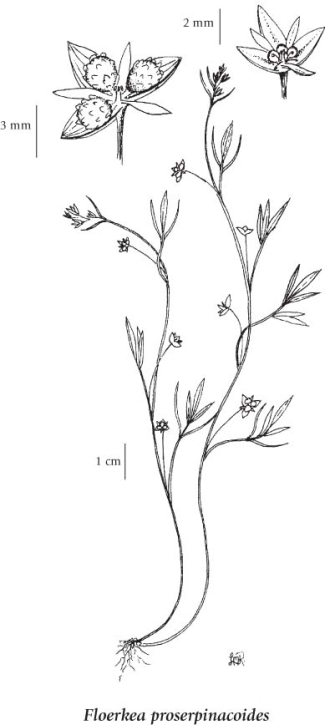false-mermaid (false mermaidweed)
Limnanthaceae (Meadow-Foam family)
Introduction to Vascular Plants
Map
Distribution of Floerkea proserpinacoides
Click here to view the full interactive map and legend
Introduction
False mermaidweed is an annual spring ephemeral that emerges in April and dies back quickly, after 60-70 days (Moorhead and Farnsworth 2003) As with other spring ephemerals, it completely disappears during the warm dry summer months. It has a disjunct but widespread range in North America (Moorhead and Farnsworth 2003), and is found in CA, CO, CT, DE, IA, ID, IL, IN, KY, LA, MA, MD, MI, MN, MO, MT, ND, NJ, NV, NY, OH, OR, PA, TN, UT, VA, VT, WA, WI, WV, WY (USDA 2010). In Canada, it is reported from British Columbia, Nova Scotia, Ontario and Quebec. In British Columbia, it is found in a handful of sites in the south-central region where it occurs in seepage areas and wet depressions in sagebrush steppe. It has been reported as an associate of Isoetes minima (Ceska and Ceska 2001). In other regions, it is found in both seepage areas and areas of poor drainage, including marshes, streams (particularly vernal streams), bottomlands, and wet open woods.
Floerkea is a weak-looking, often prostrate, mat-forming, sometimes erect, species. It is often bright green or yellow-green (Moorhead and Farnsworth 2003), with tiny white three-petaled flowers. Flowers are short-lived and rarely seen. Because of its ephemeral nature, this is an easily overlooked species. Seeds are not persistent in the soil after one year, and dispersal is short distance although periodic long-distance dispersal by water may occur (Moorhead and Farnsworth 2003). Moorhead and Farnsworth (2003) summarize this species as follows: "Floerkea has an unusual life history; it is an autogamous [self-fertilizing] annual with very low fecundity and minimal seedbanking capacity that appears to move and reestablish only sporadically among sites. These features make individual populations especially vulnerable to disturbance." The ecology of this species makes it readily threatened by invasive species such as garlic mustard (Alliaria petiolata), which can potentially smother sites and restrict germination of other species. Surveys for Floerkea need to be targeted for the relatively short flowering period of (April through June). Emergence has been reported in the spring as early as March 20 in Connecticut, with the earliest flowering date reported as April 22 (Moorhead and Farnsworth (2003). Read the report by Moorhead and Farnsworth (2003) (PDF), which provides a detailed description of this species. |
Species Information
General:
Annual herb from a fibrous root; stems decumbent to erect, few to several, sometimes branched, 2-10 cm tall.
Leaves:
Basal leaves lacking; stem leaves alternate, pinnate, with 3-7 toothed or lobed segments, lanceolate to oblanceolate, entire, 0.3-2 cm long, stalked, the stalks about as long as the leaf blades, glabrous.
Flowers:
Inflorescence of single, axillary flowers on stalks about as long as the leaves; petals usually 3, white, spoon-shaped or lanceolate, 2-3 mm long; sepals usually 3, oblanceolate, sharp-pointed, 2-4 mm long.
Fruits:
Nutlets, 2-3, more or less spherical, 2-3.5 mm wide, with small round swellings on the sides.
Illustration

If more than one illustration is available for a species (e.g., separate illustrations were provided for two subspecies) then links to the separate images will be provided below. Note that individual subspecies or varietal illustrations are not always available.
Illustration Source: The Illustrated Flora of British Columbia
Habitat and Range
Seepage slopes in the montane zone; rare in SC BC; E to NS and S to GA, VA, TN, ND, CO and CA.Status Information
| Origin Status | Provincial Status | BC List (Red Blue List) | COSEWIC |
|---|---|---|---|
| Native | S4 | Yellow | NAR (May 1984) |
BC Ministry of Environment: BC Species and Ecosystems Explorer.
Synonyms
Synonyms and Alternate Names:
Floerkea occidentalis Rydb.
References
Moorhead, William H. and Elizabeth J. Farnsworth. 2003. Floerkea proserpinacoides Willdenow, False Mermaid-weed. Conservation and Research Plan. New England Wildflower Society. Framingham, MA.